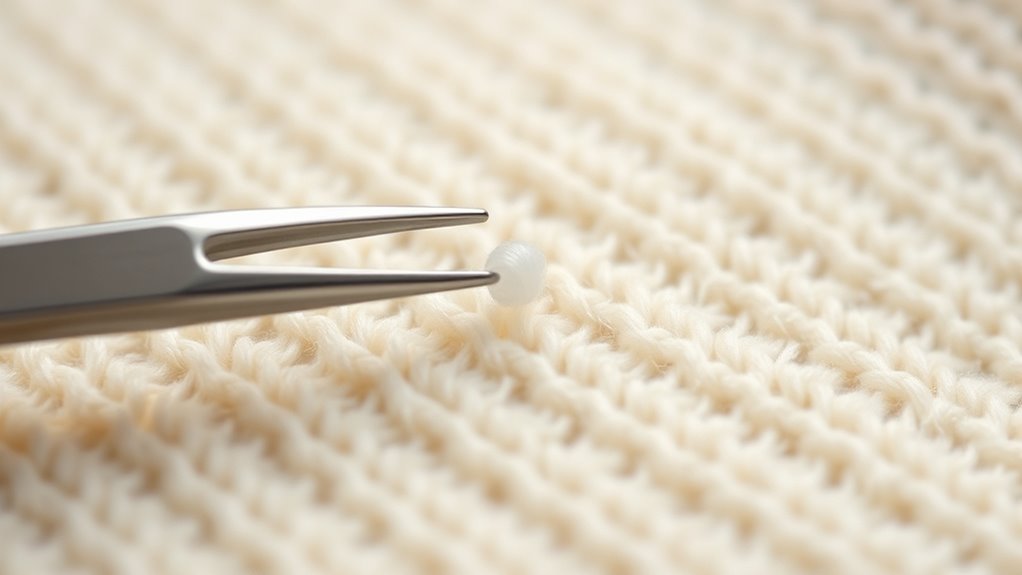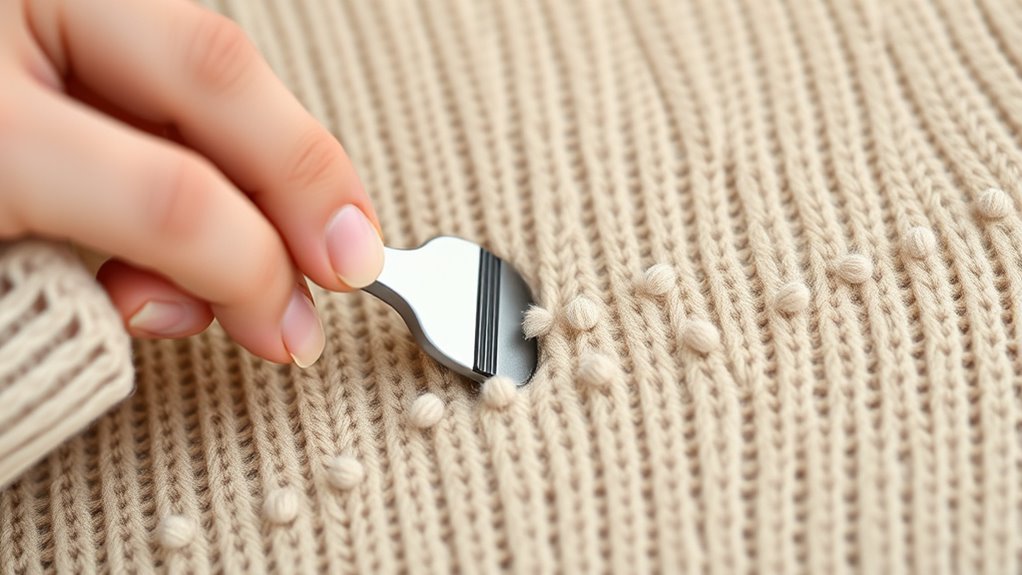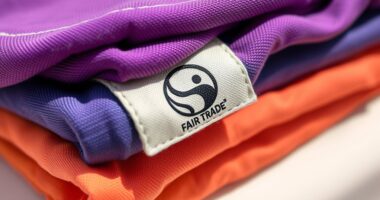To prevent and remove pilling without damaging your fabric, handle your clothes gently by washing similar fabrics together in cold or lukewarm water on gentle cycles. Avoid overloading the machine and skip harsh products or excessive use of fabric softeners, which can coat fibers and promote pilling. Use a fabric shaver or brush carefully to remove pills without harming the fabric surface. Keep these tips in mind, and you’ll find effective ways to maintain your garments longer.
Key Takeaways
- Wash delicate fabrics separately on gentle cycles using cold water to minimize fiber stress and pilling.
- Turn garments inside out before washing to reduce surface friction and fiber loosening.
- Use liquid fabric softeners sparingly and avoid softener sheets to prevent fiber coating that can increase pilling.
- Opt for air drying or low-heat tumble drying to prevent fiber damage and reduce pilling risk.
- Remove pills carefully with a fabric shaver or sweater comb without pulling or damaging fibers.

Pilling occurs when tiny fibers loosen and tangle on the surface of your fabric, causing those unsightly fuzz balls. To prevent this, it’s essential to understand how your laundry routines and fabric care choices influence pilling. One effective step is managing fabric softening and washing machine settings properly. Fabric softeners, while great for making clothes feel softer and smell fresh, can sometimes contribute to pilling if used excessively or improperly. They can coat fibers, making them more prone to friction, which encourages pilling over time. To avoid this, use softeners sparingly and opt for liquid versions rather than sheets, which tend to deposit more residues. Additionally, consider skipping fabric softeners altogether for delicate fabrics or knitwear, as these materials are more susceptible to fiber breakage.
Your washing machine settings also play a vital role in preventing pilling. High agitation or vigorous cycles can cause fibers to loosen and tangle more easily, increasing the likelihood of pilling. Instead, select gentle or delicate cycles when washing fragile fabrics or those prone to pilling. Cold or lukewarm water is preferable, as hot water can weaken fibers and make them more prone to breaking. Always check the care labels on your garments—they provide guidance on ideal washing conditions to preserve fabric integrity. Using a shorter wash cycle reduces the amount of friction, helping to keep fibers intact. Additionally, turning clothes inside out before washing minimizes surface friction and reduces pilling on visible areas.
Choose gentle cycles, cold water, and turn clothes inside out to prevent pilling and preserve fabric quality.
Another tip is to wash similar fabrics together. Mixing heavy denim with delicate knits creates unnecessary friction, increasing pilling risk. Also, avoid overcrowding your washing machine; overcrowding causes more rubbing between garments, which accelerates fiber wear. Use a gentle detergent formulated for delicate fabrics to clean without stripping fibers or damaging the surface. When possible, opt for a fabric conditioner that restores softness without adding excessive residues that can trap dirt and exacerbate pilling. Incorporating fabric quality awareness can help you choose garments less prone to pilling, thereby extending their lifespan.
Finally, always dry your clothes properly. Air drying is gentler than tumble drying, which can cause fibers to break and pill. If you use a dryer, select a low heat setting and remove garments promptly once dry. Proper laundry routines—adjusting wash cycle settings, choosing gentle fabric softening options, and following care labels—maximize fabric longevity and keep your clothes looking smooth and new, free from those pesky fuzz balls. By paying attention to these details, you help protect your garments from unnecessary friction and fiber damage, ultimately reducing pilling and extending their lifespan.
Frequently Asked Questions
Can Pilling Occur on All Fabric Types Equally?
You might wonder if pilling happens equally on all fabric types, but it doesn’t. Different fiber types and fabric durability play significant roles. Natural fibers like cotton tend to pill less than synthetic ones like polyester, which are more prone to pilling due to their fiber structure. The durability of the fabric also influences how easily pills form and can be removed, so some fabrics are more resistant than others.
Are There Specific Detergents That Help Prevent Pilling?
Oh, of course, some detergents magically prevent pilling—if only! In reality, look for detergents with gentle ingredients and avoid harsh chemicals. Fabric softener can also help by reducing fiber friction. Choose detergents labeled for delicate fabrics or designed to minimize abrasion. By paying attention to detergent ingredients and avoiding aggressive formulas, you’ll considerably lower your chances of pilling, making your clothes last longer and stay looking fresh.
How Long Does It Take for Pilling to Develop?
Pilling can develop in just a few laundry cycles, depending on fabric weave and fiber strength. If your fabric has a loose weave or weaker fibers, pills might form quickly, sometimes after only a few wears. To slow this process, you should handle your garments gently and choose detergents that protect fiber integrity. Regularly inspecting and caring for your clothes helps prevent pills from forming prematurely.
Can Pilling Be Repaired Without Professional Help?
Did you know that over 70% of pilled fabrics can be effectively repaired at home? You can try DIY remedies like using a fabric shaver or a pumice stone to gently remove pills. These simple fabric treatments won’t damage your clothes and are a quick, cost-effective way to restore your garment’s look. With patience and proper tools, you can manage pilling without professional help, saving you time and money.
Does Fabric Softener Affect Pilling Formation?
Fabric softener considerations are important because they can influence pilling formation. Using too much or the wrong type may weaken fibers, causing pilling over time. To prevent this, follow pilling prevention tips like washing garments inside out and avoiding excessive fabric softener. Remember, gentle care helps maintain fabric integrity, reducing the chances of pills forming. Keep these tips in mind to keep your clothes looking newer longer.
Conclusion
Now that you know how to prevent and remove pilling without harming your fabrics, you’ll want to stay vigilant. But what if those stubborn pills reappear unexpectedly? Will your methods hold up? Keep practicing, and you’ll master the art of maintaining your clothes’ pristine look. The secret lies in your hands—are you ready to keep your wardrobe flawless and fight pilling whenever it shows up? The next surprise could be just a step away.










